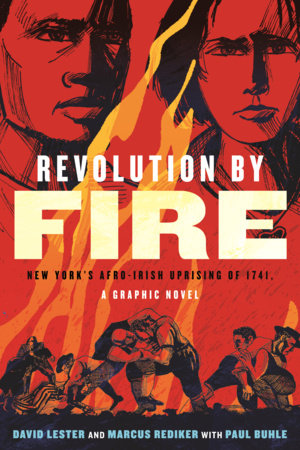Revolution by Fire Reader’s Guide
By David Lester Marcus Rediker


1. Revolution by Fire begins with an older Sarah Hughson recalling the events of 1741. While she acknowledges the importance of the meetings at the tavern as an adult, do you think that at her young age she was fully aware of their profound importance? Do you trust her memory?
2. Hughson’s tavern was a gathering place for all people. Sarah shares that “the impoverished, the cold, and the angry” gathered there, which included enslaved Africans, Irish soldiers, and others under the thumb of the elite. Considering the times they lived in, do you think it was common for such groups to meet together? How did they come to identify shared enemies?
3. The governor’s spy claimed he did not discover an actual plot in his surveillance of the local taverns. Was this because the rebels managed to keep the planned conspiracy secret? Or did he underestimate the “drunken drivel” he heard? Was an event like this easier or more difficult to keep secret in 1741 than it would be today?
4. What do you think happened to the missing spy the night Quack and Kane were discovered and Quack was arrested? Do you think the spy fled because he could have been recognized by Quack and Kane and therefore later captured, or did he fear what was to come for those like him if they succeeded?
5. Quack was arrested and banned from Fort George, which led him to return to the fort and start the fire before the conspirators are ready. When Quack is first introduced to the reader, Sarah mentions he is considered a hothead, but with so much at stake and a real chance at victory if the plan was correctly followed, could there have been another reason why Quack might have acted rashly?
6. Was Sarah Hughson arrested simply because of her father’s role in the rebellion? Or could she have posed a serious threat to the “men in ruffles” and their case against the conspirators, even as a teenager?
7. Once questioned by the prisoners at trial, witness Mary Burton claims that in addition to the accused being involved in the conspiracy, “men in ruffles” also frequented the tavern, seemingly charging these prominent men with involvement. Since the bulk of her testimony was already fabricated against the prisoners, paid for by Judge Horsmanden, what could have been her reason for making that suggestion?
8. Earlier in the story, Harriet mentions that her life had been spared after the uprising of 1712 “only because the whites feared” her curses. Do you think the judges knew about her involvement in the earlier uprising when they handed down her death sentence? Or was Harriet identified as a leader of the plot purely due to Mary’s testimony?
9. Toward the end of the story, Sarah tells Nan that the governor commuted her death sentence many times in the hopes that she would confess. Instead, she was eventually banished from the city and took Nan with her to Boston after Harriet and Peg’s friends stole her from the governor’s servant. If Sarah had given a false confession, would her fate have been like that of her father’s after all? How might the outcome for her and Nan have been different if she had bowed under the governor’s pressure?
10. Did Sarah bring Nan back to New York City for the sole purpose of telling her the story of the uprising? Or do you think the city is another focal point for the “hydra of resistance” being fanned in the “Caribbean winds”?
11. Did Sarah bring Nan back to New York City for the sole purpose of telling her the story of the uprising? Or do you think the city is another focal point for the “hydra of resistance” being fanned in the “Caribbean winds”?
12. Artist David Lester is quoted in the afterword as saying that “to draw progressive history from below I feel requires a style that is as rough as the history being depicted. For me, the imperfections and messy nature of social change, and of revolution, benefit being conveyed through drawing that is raw and bold.” In your opinion, did David accomplish this task with this story?
Just for joining you’ll get personalized recommendations on your dashboard daily and features only for members.
Find Out More Join Now Sign In